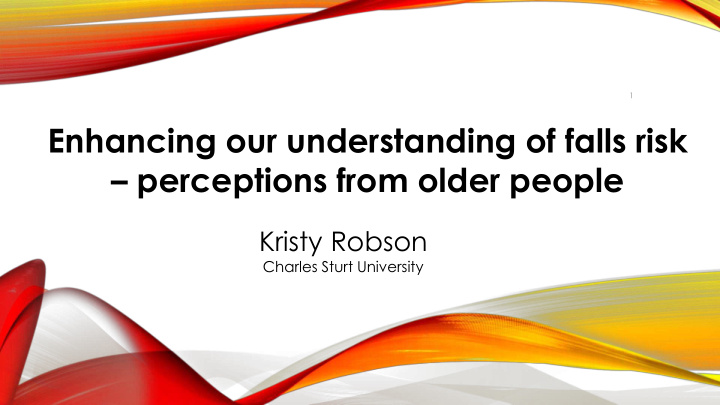



1 Enhancing our understanding of falls risk – perceptions from older people Kristy Robson Charles Sturt University
2 BACKGROUND • 1 in 3 older adults will fall annually • Age-standardised hospital admission rates attributed to falls have increased by 2% per year in Australia. • In 2001 12.4% of Australian’s were aged 65 years and over, by 2051 this group will account for 24% of the population. • Annual Australian health costs for fall related injury is expected to exceed $1.4 billion by 2051.
3 UNDERSTANDING FALLS RISK FROM THE PERCEPTION OF OLDER PEOPLE The purpose of this study was to explore older people’s: • Experience of falls • Perception of the risks associated with falls , and • Factors that informed their decisions on whether to undertake tasks that pose a risk .
4 METHODS • This qualitative study used a hermeneutic approach to explore the meaning of the experience for older people who had fallen. • Semi-structured focus groups and in-depth interviews were undertaken across southern NSW with: • 27 older people who had fallen (age bracket - 65 to 84 years, 21 female & 5 male) • 7 family members of older people who had fallen (age bracket - 45 to 84 years, 5 female & 2 male)
5 FINDINGS Thematic analysis of participant transcripts was undertaken 6 themes were identified that influenced behavioural decisions towards actively being safe or undertaking activities that could risk a fall
6 1. INDEPENDENCE I have a lovely little ladder which I’ve used for many years and it’s a sturdy, strong ladder to get to the top of the cupboards. Since we’ve both turned 80 we feel we shouldn’t use it, because it is dangerous. I haven’t stopped using it though. I used it last night. I haven’t got anybody to do anything for me, we have to be independent. (Audrey- faller)
7 2. EXPERIENCING A FALL I’m good at falling. I’ve practised a lot. Most of them are just little falls; you know you pick yourself up. I’m lucky I have never broken anything. (April - faller)
8 3. UNDERSTAND THE RISKS I get up on ladders, a stool, get up on the roof of the house, maybe it’s a risk, but if you go through life without taking any risks, you might as well be dead already. The more active you are the more you can do, the younger you remain I think. (Alfred- faller)
9 4. INTERACTING WITH SUPPORT I didn’t see the doctor, my son kept hassling me, but he didn’t need to worry. The bruise stayed there for a couple of weeks and then slowly healed. I didn’t think I needed to go [to the doctor]. (Greta – faller)
10 5. COVERING UP I lose my balance a lot and I struggle getting up and down my stairs, we’ve got stairs everywhere. They [children] would worry terribly if I told them everything so I don’t. (Gabrielle - faller)
11 6. INFLUENCES OF FINANCE I do climb up and prune trees which I know is not a good idea but it isn’t only the financial cost of having it done it’s also the finding someone who will do a decent job at a decent price and if you can’t get people in to do the job properly and it costs a lot so you’ve got to do it. (Anna - faller)
12 THEMES WERE WEIGHTED BASED ON THE PERCEPTIONS OF THE OLDER PERSON
13 CONCLUSION Managing falls risk is complex as many elements can contribute. Behavioural elements such as perceptions on risk and risk taking behaviour are likely to play a role . Behavioural risk factors As such behavioural risk factors should also be considered as part of a comprehensive approach to managing fall risk as the interplay between all three types of fall Environmental Biomedical related risk factors is likely to be the risk factors risk factors greatest threat to fall related injury
14 THANK YOU Thank you to all of the participants who generously provided their stories Professor Julia Coyle and Professor Rodney Pope Contact: krobson@csu.edu.au Ph 02 60519243
Recommend
More recommend